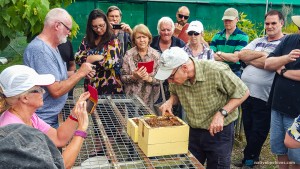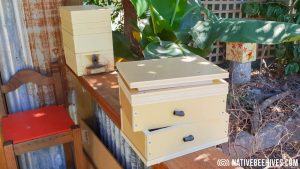What kind of timber should you use for making Native Bee boxes?

Most people will just be using what ever they have or are familiar with which is ok. I’ve used Hoop Pine, Cypress, Cedar, Victorian Ash and they all have made nice boxes. The Cedar is very soft and easy on the tools where the hardness of the Victorian Ash takes a bit more work. I haven’t actually heard of any type of timber that you can’t use.
I’d say the most common wood used could be Hoop Pine because it’s relatively cheap, easily accessible from timber yards and is already dressed (smooth surface). Some timbers you might buy from a wood yard could be rough sawn so will have a rough surface and inconsistent thicknesses and will need Thicknessing (machined down to consistent thickness) so it’s always best to check what kind of timber you’re buying and what needs to be done to it to get it to the building stage.
Also consider the measurements of the timber you’re buying. If you get 35mm thick by 90mm wide then that may reduce the amount of work you have to do.
Test Test Test…
- Start out by making boxes for yourself and monitor the build quality over years. You might think your boxes are great when you’ve finished them but in one/two/six months they could have all warped.
- Wood like Cypress can be popular because it looks great new and is termite resistant but really needs plenty of time to “season” or dry out. It’s very unlikely you will find kiln dried Cypress. Cypress boxes should be made over many months and not over days or weeks. They will continue to warp and over many months. The frames will twist and the top lid and bases will cup.
- Test: Make some single frames, get them perfect so they sit against each other with no gaps and no rocking, then leave them alone for a month or two, then sit them against each other again and check the gaps and rocking. This will give you an indication of how stable the timber is.
- The same applies for the coatings. Testing should be done over a year or so. You’d want a good idea of what will happen to your boxes with bees inside and exposed to the elements.
Hoop Pine
Hoop pine can be easily sourced and a lot of people build hives from Hoop Pine. It can be more susceptible to rot, fungus and termites Try to place the hive under shelter and not in bushland and check the structure when you do your splits. That’s being extra cautious really and they’d probably be fine for many years. Make sure you give the finished hive a few coats of good exterior paint and provide protection from the elements with a good roof. Water can run down the sides of a box and enter through where the boxes sit together and this can end up causing the boxes to rot.
- + Kiln dried
- + Consistent quality which makes it more appealing to people
- – Becoming difficult to source
- – Not as resistant to rot as some other timbers
Cypress

Cypress can be a brittle type timber and a real challenge with all it’s chips and splits. It’s not unusual for it to be bowed or twisted and you may end up throwing away some of it if it’s not suitable or use it on a different project. It continues to shrink, expand, split and bow so you’ll need a good understanding of how Cypress behaves over time.
- + Some of the Knots can look great as a feature.
- + Not termite proof, but is naturally Termite resistant and can last many years outside.
- – Unlikely to find kiln dried so must be seasoned/dried/aged. It’s important to check moisture content before using.
- – Inconsistent quality
- – Will continue to warp after you’ve made your box
- – Avoid using 25mm thick Cypress for tops and bases as it will warp and open up gaps in your box. Go thicker to reduce this problem, but even 50mm thick cypress warps
Cedar

- + Relatively easy to work with. Light and soft, should have good insulation properties
- + Termite resistant – Will last for a long time
- + Good insulation properties
- – Expensive
- – Difficult to source
Thickness
I’d recommend thicknesses from 25mm to 50mm.
If the only timber you can get is 20mm thick you could put two pieces together to make it 40mm, or build the 20mm thick box and stick another layer of 20mm around it. Thickness can also depend on insulation properties and your location…
Insulation Properties
Note that soft lighter woods may have better insulation properties compared to hard dense woods so this can also be taken in to consideration depending on your locality and climate. If you have long periods of extreme cold or hot temperatures then it’s more important to consider thicker timbers or the insulation properties.
Timber Warping
The timber you buy may look perfect but it can continue to dry, shrink, twist or expand with moisture and shrink unevenly. Timber grain can be under tension and when you cut the lengths in to short pieces the tension can change and the short pieces may twist and warp over time. It can be very frustrating. If you have the time, you can cut all the pieces and then stack them up to air dry and age for a few months and by watching them you may get an indication of how stable or unstable they are. It’s quite possible that the older the timber the more stable it is, so if you have some old timber that’s been sitting there for 10 years but still in good condition it may be a good option.
Other materials
I would not recommend these materials for long term boxes as it will swell when it’s exposed to moisture and break apart.
- Some cheaper Plywood
- MDF
- Chipboard
Wood Preservatives
Manufacturers advise against using these treated timbers if it comes in contact with drinking water or food.
A lot of these you could season or age and the levels would be minimal for hive construction and the bees would be fine, but because honey is for human consumption it’d be safer not to use it. You can use these for stands and roofs, it doesn’t bother the bees. I’m sure there’d be a lot of home made hive boxes out there using these materials.
Chances are that it could be perfectly safe, though i’m not aware of any testing or research that has been done with regard to Native Bee Hive honey and chemicals used with wood.
- CCA: Copper, Chrome, Arsenic
- LOSP: Light Organic Solvent Preservative
- MicroPro Sienna: New treated pine product with a pink appearance.
- ACQ Preservative – Alkaline Copper Quarternary – Does not contain arsenic
- Cuprinate – Not classified as a Carcinogenic
- Formaldehyde – Use in Plywood – https://www.famitchell.com.au/formaldehyde-plywood/
You might find the pine you buy from popular large hardware stores could be treated with ACQ and you wouldn’t know it. Any timber you use on hive boxes should be lightly sanded and once the box is finished you should age it a little.
Termites:
Some timbers are more susceptible to Termites. If you’re making a hive and placing in your garden on a stand or have it on your balcony or patio then the chances of seeing Termites are pretty low. If your boxes are going in to the bush or on a farm then the risk is higher. I think some people can worry a bit too much about Termites, you just have to look at where your boxes are being placed.
**Toxic Wood!
Wood is a great natural product but the dust can have negative impacts on your health. When working with wood you usually create dust and some species are called “sensitisers”, that means repeated exposures to skin or breathing it in can result in a reaction to the material.
Anyone creating saw dust should always wear a good quality dust mask and also use a dust extraction system on power tools in the workshop.
Get a good quality dust mask with a “P2 filter”. The cheap paper masks or even the slightly better dust masks from the major hardware stores don’t seal around your face that well so don’t stop you breathing dust.
- Cypress dust is very harmful to the respiratory system
- Cedar can cause skin reactions and is harmful to the respiratory system
Statistics for timber – Unpainted. *If protected these could all last a lifetime
Hoop Pine
- Termite Susceptible
- 5 years below ground, 7 years above ground
Cypress
- Termite resistant
- Greater than 25 years in ground, 40 years above ground
Tallowood
- Termite resistant
- Greater than 25 years in ground, 40 years above ground
Cedar
- Termite resistant
- 5-15 years in ground, 15-40 years above ground
Victorian Ash
- Not Termite resistant
- 0-5 years in ground, 7-15 years above ground
If your hive box is painted and raised off the ground then you’ll probably never worry about Termites being an issue.
Moisture Content
My article about Moisture Content https://www.nativebeehives.com/moisture-content-wood-hives/
Good shelter
If you’re placing your hive box in the weather it should have some kind of roof to protect it from the rain. If water is allowed to run down the sides it can get in to the seems between the layers and possibly cause mould and rot.
Let me know what timber you’re using and how it went!













